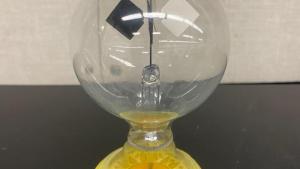A Crookes radiometer consists of an airtight glass bulb with a partial vacuum inside and a set of vanes (one side black, the other side white) free to rotate about a low-friction central axis. When exposed to light, the vanes rotate, demonstrating the conversion of light energy into mechanical energy (a heat engine powered by light). The speed of rotation is proportional to the intensity of the incoming light.
The current accepted mechanism for why the vanes rotate is a process called thermal transpiration. When light hits the vanes, the black side absorbs more light than the white side, causing the air molecules on/near the black side become more energetic and heat up. This causes air inside the radiometer to move from the colder side to the hotter side, creating a pressure differential, causing the vanes to spin, with the black side moving away from the light source.
Radiometer, laser or light source
Basic laser safety if using one
